Chaga is an strange-looking mushroom that has some impressive health benefits.
But what is chaga mushroom exactly?
You are viewing: Where Do Chaga Mushrooms Grow
For centuries, chaga has seen use across Asia and Eastern Europe for its medicinal benefits. Now it’s becoming popular in the Western world as well. People consume chaga for its reported immune-boosting and cancer-fighting properties and other potential benefits.
The downside is that you can’t just eat chaga like the mushrooms that you find at the grocery store. It’s extremely hard and dense. Most commonly, chaga gets ground into a powder and made into a tea.
In this guide we’ll explain what chaga is, what it looks like and how to prepare it. You will learn where it grows and how to harvest it yourself, or where you can purchase it instead.
We’ll discuss the many health benefits of chaga, as well as some potential side effects that you should keep in mind.
What Are Chaga Mushrooms?
Chaga is a variety of parasitic fungus that is primarily found growing on birch trees in cold climates. You can find it in Alaska, Northern Canada, Northern Europe, Korea, Russia and Siberia.
The Latin name for chaga is Inonotus obliquus. Roughly translated, this name means something like “fibrous sloping ear.” The word chaga comes from the Russian name for the mushroom.
Chaga goes by several other names, depending on where you live.Some of these include the cinder conk, black mass mushroom, birch canker polypore and clinker polypore.
In Norway, chaga gets referred to as kreftkjuke. Literally translated, this means “cancer fungus.” This is quite interesting given the health claims made about this fungus and its ability to fight cancer.
Another popular medicinal mushroom is Reishi. Read A Complete Guide to Reishi Mushrooms to learn more about it.
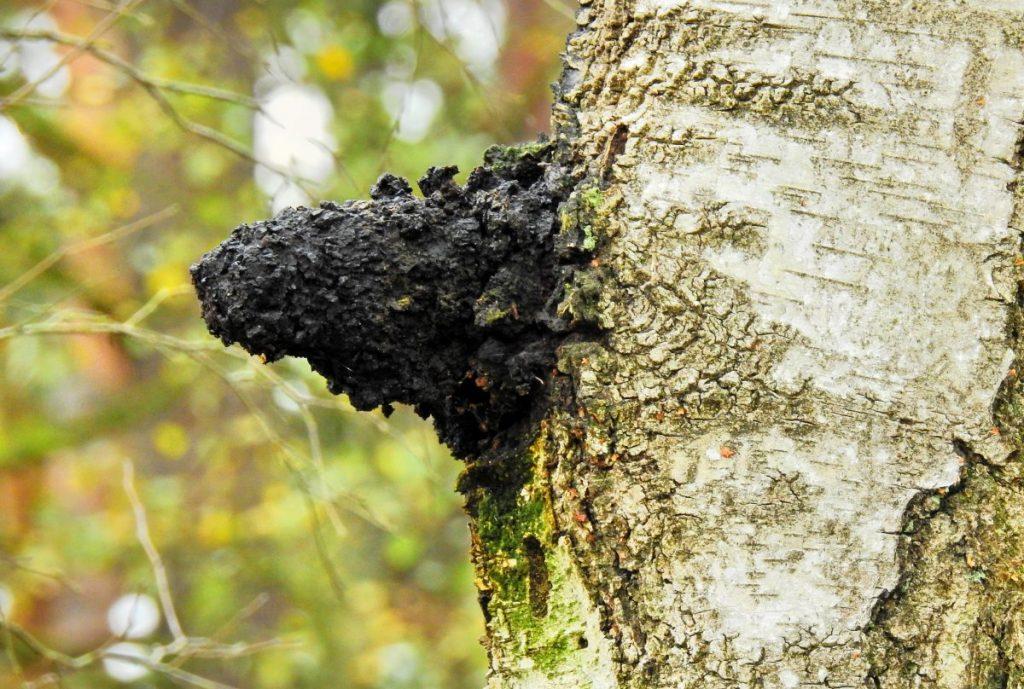
What Do Chaga Mushrooms Look Like?
The best way to describe a chaga mushroom is that it looks like a large chunk of burnt charcoal on the side of a tree.
The outer layer of the chaga is dark black and very hard. Inside is a softer orange-colored core.
The deep black color of chaga is due to large amounts of melanin inside the outer layer.
Melanin is the same pigment in human skin that allows us to tan when exposed to sunlight.When chaga first emerges from a host tree it is an orange color. It develops its dark color over time as it becomes exposed to sunlight.
Chaga mushrooms are about 10 to 16 inches across (25 to 40 centimeters).
With most mushrooms, you see the fruiting body but the mycelium is hidden. With chaga, it’s the opposite. The large mass you see on the outside of the tree is actually a collection of mycelium called a sclerotium.
The fruiting bodies of a chaga mushroom are inside of the host tree and are rarely seen.
How To Cook With Chaga Mushrooms
Like most conk or shelf mushrooms that grow on trees, chaga is far too tough and woody to use in normal recipes. So we need to use chaga mushroom in a different way.
The traditional way to consume chaga is to dry it out and then grind it into a fine powder. Then you can use the powder to create a warm drink similar to tea or coffee. You can also make this tea from whole chunks of chaga.
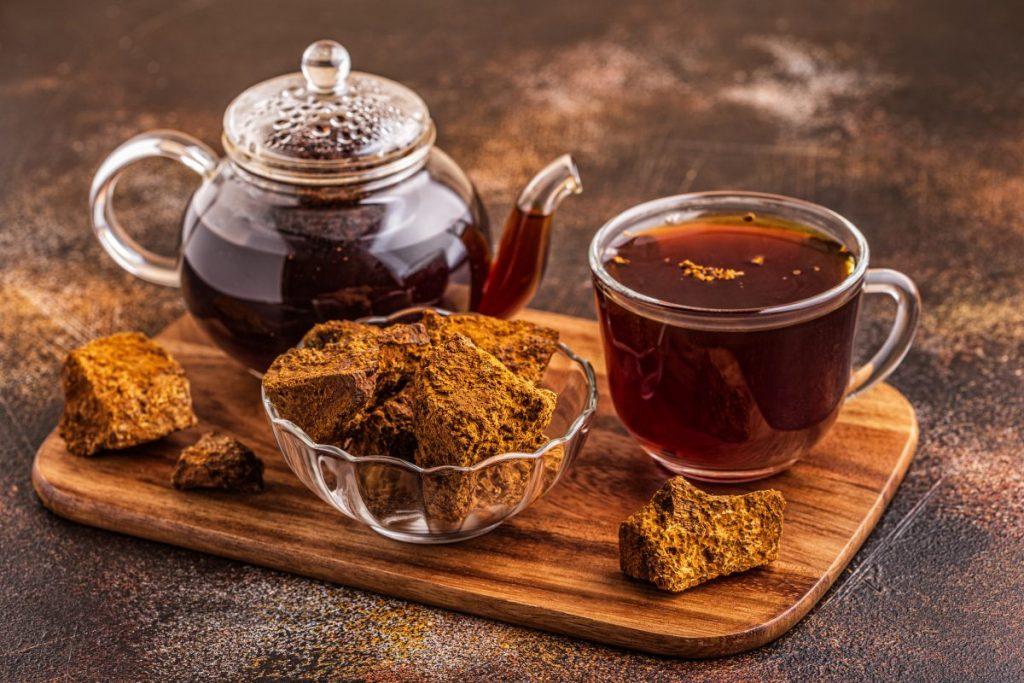
How To Make Chaga Mushroom Tea
To extract all of the beneficial compounds from chaga, you need to let it simmer in hot water for 10 to 15 minutes. It’s best to do this on a stovetop instead of simply pouring boiling water from a kettle over your chaga.
Hot water from a kettle is unlikely to stay hot for long enough for a proper extraction.
Instead, bring a pot with four cups (one liter) of water to a simmer. Then all you need to do is add your chaga that has been powdered or cut into small chunks and wait.
Some people prefer to brew large batches of chaga tea at a time. They will simmer a large pot of water for two or three hours. This really helps to ensure that you’re extracting all of the medicinal properties from the mushroom.
Once you’re done simmering your tea, simply strain out the chaga chunks from it.
Chaga tea should get consumed immediately while it’s still hot. You can sweeten your chaga tea with sugar, maple syrup or honey. You may even choose to add milk to it for a more traditional tea experience.
Any leftover tea can get refrigerated for up to seven days. You can either reheat it, or use it to make a cold drink more akin to iced tea.
Other Chaga Preparation Methods
There are a couple other methods of preparing chaga. These are alcohol extraction or fermentation.
However we don’t recommend trying these at home.
An alcohol extraction requires the use of ethanol or methanol and a bit of chemistry to isolate different chemicals in the chaga.
If not done correctly, harmful chemicals can get left behind in the process. So if you’re looking to use an alcohol-based chaga tincture, we recommend buying it from a reputable supplier instead.
Likewise, fermentation of chaga has some risks too. Not only is it time-consuming, but it comes with a high risk of your chaga developing harmful bacteria and mold in the process. So for the time and effort required to obtain the same benefits, we recommend just making chaga tea instead.

How Do You Eat Chaga Mushrooms?
Chaga can’t be eaten like regular culinary mushrooms that you can find at the grocery store. It’s so tough and fibrous that it would be like eating a piece of birch bark!
The primary way to consume chaga is in a tea as discussed above. You might also want to try experimenting with adding powdered chaga to smoothies, soups and other recipes as well.
You can also take powdered chaga as a supplement in capsule form. This can be more pricey than preparing chaga yourself, but it’s definitely the quickest and easiest.
What Does Chaga Taste Like?
From looking at it, you’d expect chaga to have quite an unpleasant taste. It’s not the most aesthetically-pleasing mushroom, so you might expect that it will taste quite bitter and strong.
Luckily though, chaga actually tastes quite mild. Even a little bit sweet or fruity.
Read more : Where Is Jade Janks Now
Chaga contains a naturally-occurring compound called vanillin. It’s the same substance that gives vanilla beans their taste. So if you are noticing a subtle vanilla flavor from your chaga tea, it’s not your imagination!
Of course the most common word used to describe mushroom flavor, “earthy,” also applies.
But it’s definitely safe to say that chaga doesn’t taste like the usual mushrooms that you’d find in your supermarket’s produce section.
Different factors will impact the taste of chaga. These include where it was grown, how it was harvested and processed and how fresh it is.
If your chaga does have a particularly bitter or off taste to it, it’s best to discard it. This is a sign that it has probably been contaminated by mold or otherwise spoiled.
Medicinal Use of Chaga Mushrooms
What is chaga mushroom good for? That’s the question that you’re probably wondering, if you’re going to go to the effort of preparing and consuming chaga tea.
Chaga mushroom benefits have been known for centuries.Chaga has a history of use in Russia, Asia, as well as by native Americans.
In some cases it’s used as a general cure-all to promote health and boost immunity. Other times it gets used as medicine to treat a specific condition.
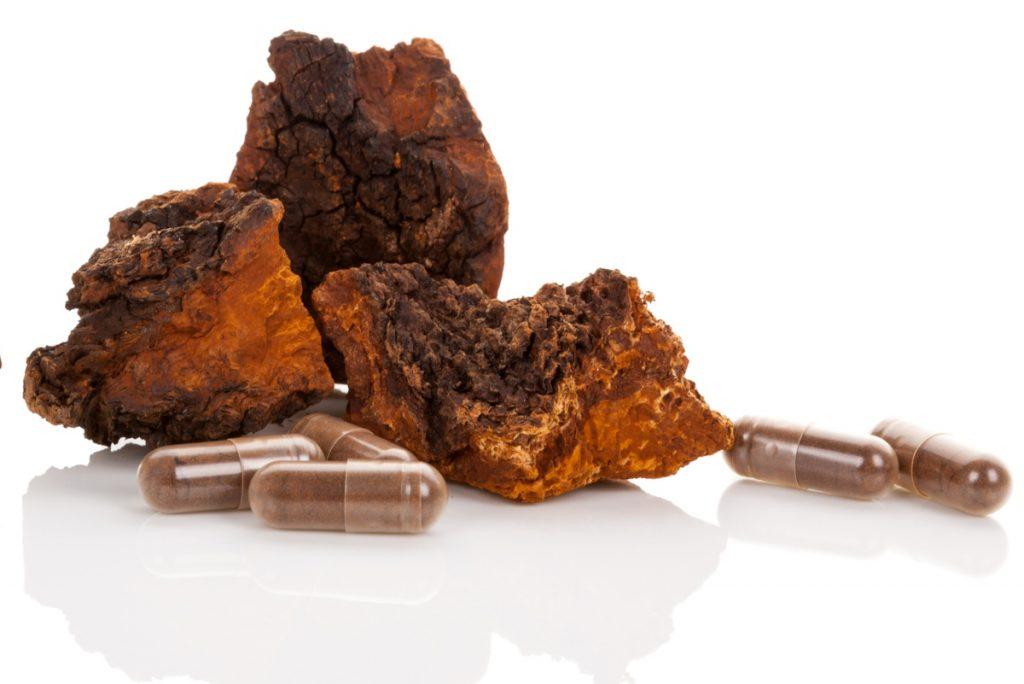
Health Benefits of Chaga Mushrooms
Here are some reasons why you might want to add chaga to your health routine.
Please note that most of these health claims made about chaga are still in their preliminary stages of research. More work needs to be done to conclusively prove these claims, as only small-scale studies have been done.
However we still think chaga’s health benefits are impressive enough to be worth consideration.
- It’s a superfood. Chaga contains plenty of different vitamins and minerals that are important for our bodies to function. These include B vitamins, Vitamin D, potassium, zinc, iron, various amino acids and more. If you consume chaga powder instead of straining it out of your tea, it’s also very high in fiber.
- Lowers blood sugar. Chaga is shown to lower blood sugar in a study with rats. This looks promising as a potential treatment for diabetes in the future.
- Helps fight heart disease and lowers cholesterol. Consuming chaga mushrooms may help to lower your LDL, or “bad cholesterol” levels. Having high cholesterol is a major risk factor for heart disease.
- Protects the liver. Chaga may be useful to help patients with hepatitis, alcohol-induced liver toxicity, or other conditions that affect the liver. It has shown to have protective effects on the liver. Including slowing or preventing some liver problems.
- It may help slow aging. Chaga is very high in antioxidants. These compounds help to remove oxidative stress from the body, which is partly responsible for visible signs of aging. So adding chaga to your diet may help keep those wrinkles and gray hairs at bay.
- May prevent, slow, or help fight cancer. Studies are being done on the cancer-fighting effects of chaga. Early research is showing that chaga can slow the growth of certain types of cancer in a lab setting.
A substance found in chaga called triterpenes has even been shown to cause tumor cells to self-destruct while leaving healthy cells unharmed. More research needs to be done, but initial results are looking promising.
Many mushrooms provide similar benefits. Learn more by reading Health and Nutritional Benefits Of Mushrooms
Chaga Mushroom Potential Side Effects
While chaga has numerous benefits, it may not be a good choice for everyone. There are some chaga mushroom side effects to be aware of too.
- Kidney stone risk. Chaga has some of the highest concentrations of oxalates of any food out there. Oxalates can bind with calcium as they leave the body and result in kidney stones in some people. People who are prone to kidney stones should definitely avoid consuming chaga.
- Bleeding disorders. Chaga may lower blood pressure or increase the risk of bleeding. If you have a bleeding disorder that affects blood clotting such as hemophilia or von Willebrand disease, we recommend avoiding chaga.
- Pregnancy. The effects of using chaga during pregnancy or breastfeeding is currently unknown. It’s best to avoid consuming chaga when pregnant just to be safe.
- Diabetes. Chaga may cause significant lowering of blood sugar levels. People with a history of diabetes should closely monitor their blood sugar levels. Watch for signs of hypoglycemia (low blood sugar) if you’re going to try adding chaga to your diet.An adjustment to your diabetes medications may be required if you start taking chaga. It’s best to talk to your doctor before you start to consume chaga.
- Surgery. You should stop taking chaga at least two weeks before any scheduled surgery. Since chaga can affect bleeding and blood sugar, it may present complications in surgery.
- Autoimmune diseases. Taking chaga may irritate or cause some autoimmune diseases to become more active. Examples include lupus, rheumatoid arthritis and multiple sclerosis.
Where To Purchase Chaga Mushrooms
Chaga is not commonly found in health food stores, pharmacies or any other shops that you’re likely to have in your local area. It’s a bit of a lesser-known or uncommon health product.
So where to buy chaga mushroom? Most people who purchase chaga will order it online.
A quick search on Amazon will reveal whole chunks of chaga, as well as tea powders and capsules for sale. Ordering from sellers on Amazon can be a viable option. But make sure to do your research and verify that you’re buying from a reputable company.
If possible, we recommend finding a website for a company in your country who you can buy chaga from directly. This may be a site that specializes in medicinal mushrooms in general. Although some chaga harvesters and sellers may have an entire website or business devoted to just chaga.
We feel that buying directly from sellers is likely to get you a fresher and higher-quality product.
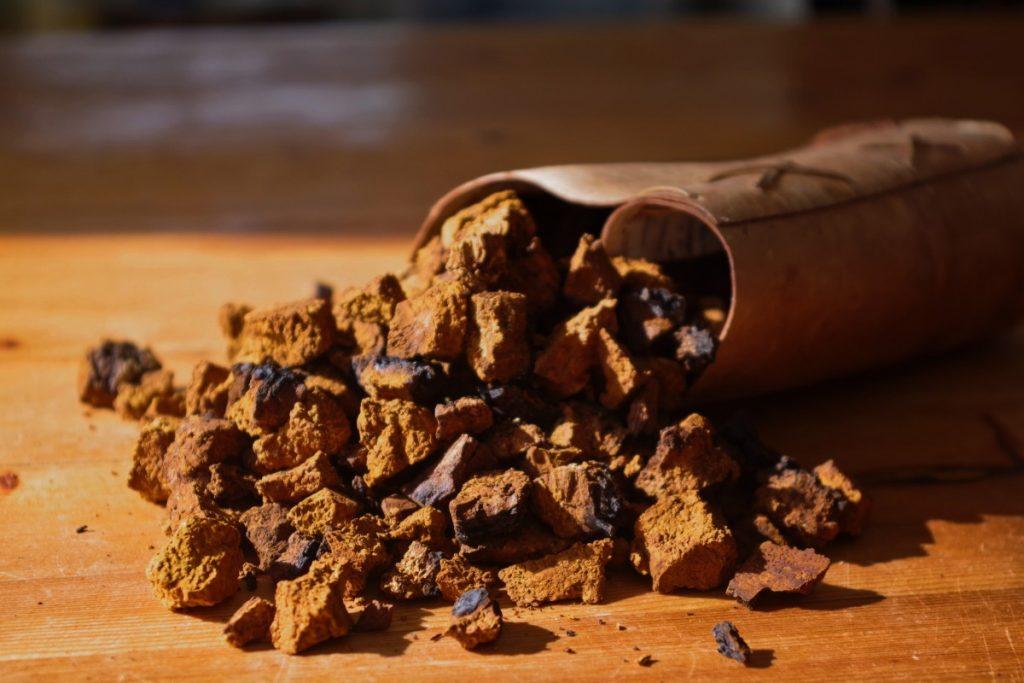
How To Store Chaga
Fresh chaga is susceptible to mold. If you’re drying it yourself, you should do so in a warm, dry, well-ventilated area. Larger pieces of chaga should get cut into chunks no larger than 3 to 6 centimeters (1 to 2 inches) before drying. You will know that your chaga is sufficiently dry when it becomes crumbly and hard.
Even if you purchase chaga that is already dried or powdered, it needs to be properly stored to maintain maximum freshness.
A glass jar with a tight-fitting lid is best. Add a food-safe silica packet or oxygen absorber to minimize the risk of moisture in the container. Then put your jar of chaga in a cool, dark place that won’t be subject to temperature fluctuations.
Properly stored chaga will retain its medicinal compounds for up to two years.
How To Find and Identify Chaga Mushrooms
If you live in an area where it’s known that chaga grows, you may want to consider trying to find and harvest some yourself. Once you know what to look for, it can be a great alternative to buying it.
Chaga doesn’t have very many look-alike mushrooms. We also aren’t aware of any look-alikes that are poisonous. So that makes chaga a relatively safe type of fungus to try and harvest yourself.
Where Do Chaga Mushrooms Grow?
Chaga mushrooms are found in cold climates. You’ll have the best luck finding chaga in Northern Canada and the United States, Russia and Northern Europe.
The vast majority of chaga mushrooms grow on birch trees. So you’ll have the greatest success in your hunt by looking in forests that contain a large proportion of birch trees.
When figuring out where to find chaga mushrooms, it’s important to know where to look on the tree for it too.
Chaga mushrooms can grow all along the trunk of a tree. Although they are most common at about head height or higher. You may need to do a bit of climbing to reach all of the chaga mushrooms that you come across.
When Are Chaga Mushrooms In Season?
You can find chaga all year-round. It’s best to look in late fall or winter though. It’s widely believed that when birch trees go dormant during colder months, more of the tree’s energy and nutrients get stored in the chaga.
In the spring and summer when the sap in birch trees begins to flow, the chaga that you harvest may be of a lower medicinal quality.
Since chaga spends its summers growing and goes dormant for the winter, you also increase your chances of harvesting larger chaga specimens that have been growing all year long if you look for them later in the year.
Lastly, chaga is much easier to spot in winter when trees have dropped all of their leaves. Look for the contrast of big black chaga mushrooms against the white bark of the birch trees.
If you’re interested in exploring other types of medicinal mushrooms, be sure to read Medicinal Mushrooms: The Complete Guide.
How To Harvest Chaga
If you look up videos of people harvesting chaga on Youtube, you’ll commonly see people digging axes or knives into trees in order to harvest the entire fungus.
We highly discourage this behavior as it’s not very sustainable.If you remove the entire chaga, it’s like stripping most of the mycelium away. You will most likely kill the fungus in the process. Not to mention that you will probably inflict unnecessary damage to the tree in the process as well.
Instead, we recommend taking only a small piece off of each chaga mushroom with a sharp knife or axe. This gives the mushroom a chance to scar over and regrow. Leaving most of the mushroom intact also protects the tree. If you harvest the entire chaga, you leave a gaping hole in the tree where contaminants and cold can cause harm to it.
Harvesting a little bit of chaga from multiple trees should still provide you with plenty of mushroom to last you for months. Plus you are creating a more sustainable environment that you can return to year-after-year for more chaga.
Read more : Where To Go For Birthday Dinner
Avoid harvesting chaga from dry or dead trees. Once a tree is dead, the chaga growing on it will also begin to die and get contaminated by other types of fungus.
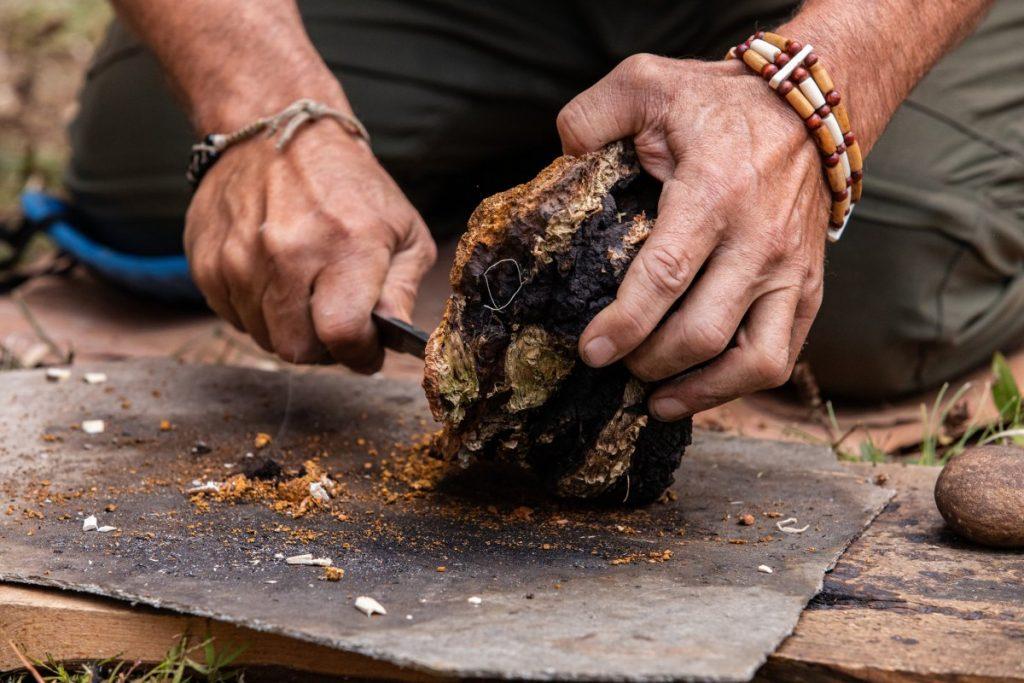
How To Clean Chaga
Once you’ve separated a chunk of chaga from a tree, there is a bit of work that needs to get done to prepare it for drying and consumption.
There is some conflicting information on exactly what parts of the chaga mushroom are the most medicinally potent. Some sources say that the black outer parts are the best. Others say that the orange inner portions are most potent.
However it’s generally agreed that the most light-colored inner portions where chaga attached to the tree are lowest in nutrients. This part of the mushroom has a texture like cork and you can peel it off with your finger. Use a knife to remove any pieces of bark or wood that is embedded in the mushroom.
For drying your chaga, we recommend cutting it into cubes smaller than 1 inch (2.5 cm) to prevent mold. Chaga is hard and dry, so you may need to use a saw if a regular knife won’t do the job.Once cut up, you can put the pieces out in the sun to dry for a few days.
To powder chaga yourself, we’ve found the best tool for the job is a chisel or rasp. Simply grind the chaga against the tool. The fine side of a cheese grater may also work as long as the chaga isn’t too hard.
How To Choose The Best Chaga
Chaga potency can vary significantly between suppliers. Or even between different mushrooms from the same supplier.
Since chaga is a herbal remedy, there isn’t necessarily a good way to test for purity of a particular mushroom or establish a standard dose. There are a few things to look for to try and get the best chaga available though.
Read the label. Do your due diligence and read all of the information presented before buying chaga. The label should tell you the country of origin. It’s also important to check if you’re getting pure chaga or if it has been blended with any other ingredients.
Ask for testing. Some chaga sellers may get independent testing done on their chaga by a lab. This will provide you with tangible information about the different compounds in their chaga.
There will still be variation from mushroom to mushroom. But testing gives you a good general idea of the quality in the area that they are harvesting from.
Look at the color. When buying chaga powder, you can roughly tell if the mushroom had its black outer layer removed before being ground or not. The powder will vary in color from light orange to dark brown, depending if the outer sclerotium layer is included or not.
This is largely a personal preference. Some people may want the black outer layer included, while others only want the inner orange part of the chaga.
Make sure it’s organic. Since there isn’t much testing or standardization done with chaga, we feel that it’s important to buy it organic. That means chaga harvested from an area without pesticides and with no dangerous chemicals used during cleaning and processing.
Our article Medicinal Mushroom Extracts and Supplements: A Buyers Guide contains some more general information on what to look for.
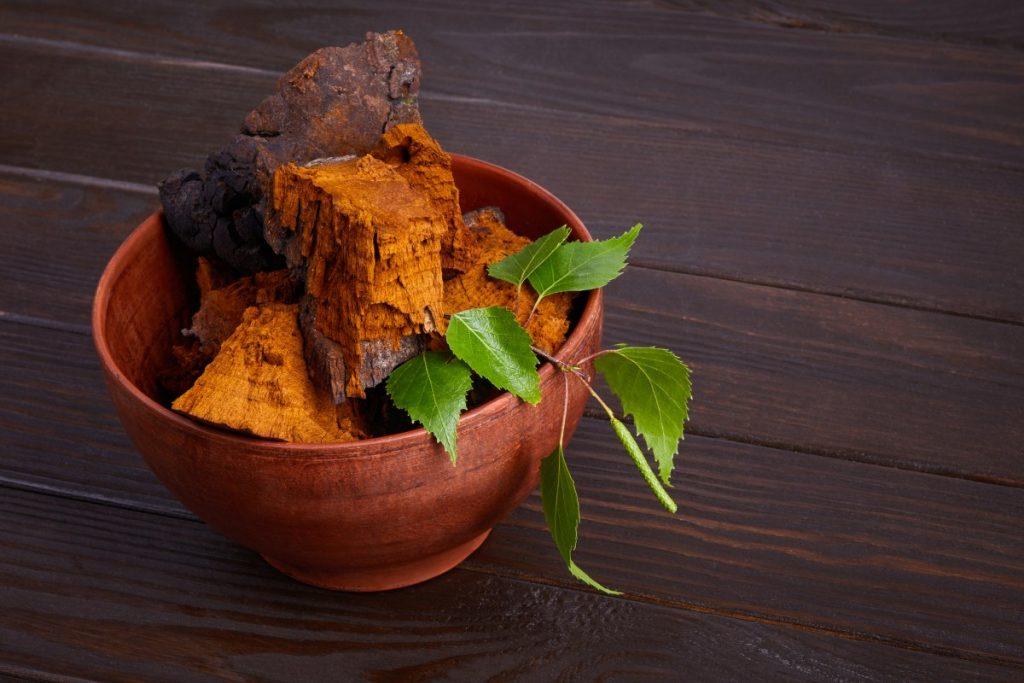
Types of Chaga
There is only one species of chaga, Inonotus obliquus. However we can break each mushroom down into roughly three parts.
First you’ve got the outer black layer. This part of the mushroom is very hard and dense.
In the middle there is a medium-density layer. It’s dark orange in color. It’s not quite as hard as the outer layer. You can dent it by pressing your fingernail into it.
The most inner layer of the chaga mushroom is light orange and has a cork-like texture that can be easily peeled away.
All three layers are useful for medicinal purposes. The inner and outer layers can also be used when out in the wilderness as tinder for starting a fire too.
Chaga Mushroom Look Alikes
When you’re looking for chaga mushrooms, the softer orange inside will be the biggest giveaway. This separates it from most of its lookalikes.
One similar-looking mushroom is the meshima mushroom, Phellinus linteus. It grows in more of a horse hoof shape and isn’t a dark black color like chaga.
It also tends to grow on mulberry trees instead of birch. meshima mushrooms have a bitter taste. Although they aren’t chaga, they do have some medicinal benefits of their own.
The more common lookalike is the black knot fungus, Dibotryon morbosum. This dark black fungus is more commonly found on the branches of trees. But particularly large specimens growing on the trunk may resemble chaga. The biggest giveaway is that they are not orange inside.
So if you’re ever unsure whether you’re looking at chaga or something else, just break it open and look for the orange coloration.
How To Grow Chaga At Home
Inoculating a tree at home with chaga is very difficult. Since the external part of chaga that we harvest isn’t the fruit body, it doesn’t contain any spores that we can simply use to start growing more mushrooms from.
In nature, birch trees that have open wounds become contaminated from chaga spores that are carried on the wind.
If you live in an area that already has trees with chaga, your best chance to get chaga to grow on a particular tree is simply to cut into it and create a wound. Then hope that some chaga spores blow past and colonize your tree.
There are a few problems with doing this though.
The first is that eventually, a tree infected with chaga will die. The mushroom continues to grow until it completely blocks the circulation of sap within a tree and kills it. Although this can take many years.
The second is that chaga can take many years to first get established in the first place. Even if you could create a wound in a tree and expose it to chaga spores, it will be years before you know if your experiment was successful or not. It can take five or 10 years for chaga to start showing up on the tree.
So growing chaga at home is not really practical or realistic. We recommend just buying your chaga online or looking in the wild for it instead.
Maybe if you’ve got a few acres of birch forest on your land, then it might be worth trying to encourage chaga to grow there. But in a backyard for one or two birch trees, not so much.
Final Thoughts
Chaga mushrooms aren’t particularly nice to look at. They look like a large ball of burnt charcoal.
They aren’t really edible either. They’re tough and woody and need to be made into a tea or powder to consume.
Still, their numerous purported health benefits might make it worth the effort of gathering and preparing them.
If you live in a cold climate with lots of birch trees, you might be able to go for a hike and find some wild chaga to harvest. Otherwise you can always buy it online from a reputable seller.
For certain use cases, chaga might be just the medicinal mushroom that you’re looking for.
Source: https://t-tees.com
Category: WHERE
